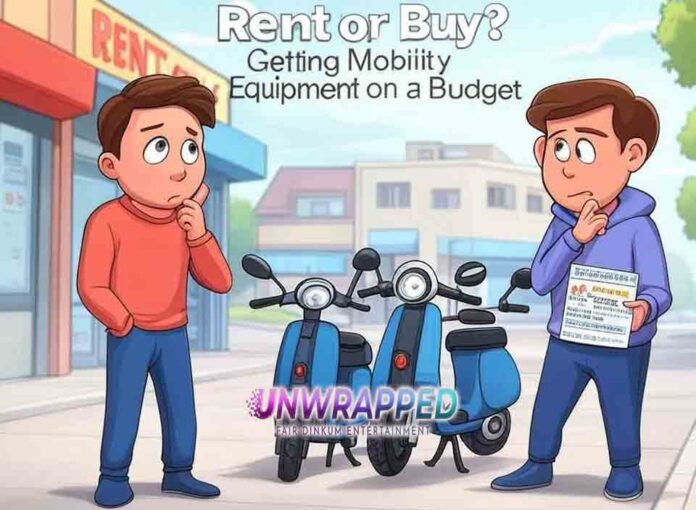When it comes to getting mobility equipment, one of the key decisions is whether to rent or buy. Both options have their benefits, and the best choice depends on your specific situation, such as the length of time you’ll need the equipment, your budget, and how often you’ll use it. Here’s a breakdown of the pros and cons of renting and buying mobility equipment, along with some tips on how to make the most of your budget.
Renting Mobility Equipment
Renting can be a great option if you need mobility aids for a short-term period or if you’re unsure about which model is the best fit for your needs.
Benefits of Renting:
- Lower Initial Cost:
- Affordable for short-term use: Renting mobility equipment often requires little upfront payment compared to buying. This can be ideal if you only need equipment for a limited time, like after surgery or during travel.
- No large upfront cost: Renting allows you to access the equipment immediately without having to invest a large sum, which is ideal if you’re on a tight budget.
- Flexibility:
- No long-term commitment: Renting gives you the flexibility to switch between different types of equipment based on your needs or preferences. If your condition improves, or if you need something different (like a wheelchair instead of a walker), you can change equipment easily.
- Temporary needs: If you need mobility aids for a specific event, a vacation, or a short period, renting is more convenient and less expensive than buying.
- Maintenance and Repairs Included:
- No worry about repairs: With rentals, the rental company typically takes care of maintenance and repairs, which can save you money and hassle in the long run.
- Insurance Coverage:
- Some rental companies accept insurance, meaning your policy may help cover the cost of rentals, especially if the equipment is medically necessary.
Drawbacks of Renting:
- Higher Long-Term Costs:
- If you need the equipment for an extended period, renting can become more expensive in the long run compared to buying outright.
- Limited Selection:
- Rental companies may not have the exact model or features you’re looking for, so you might have to settle for a less ideal option.
- Availability Issues:
- Popular equipment may not always be available, especially during busy times or high demand periods, which could lead to delays in getting the mobility aid you need.
Where to Rent Mobility Equipment:
- Medical supply stores: Many stores offer rental options for wheelchairs, walkers, scooters, and more. They usually have short-term and long-term rental agreements.
- Online rental services: Some companies allow you to rent equipment online and have it delivered to your home. Popular options include Scooter Direct and Rent-A-Wheelchair.
- Hospitals and rehabilitation centers: Some medical facilities or local hospitals offer short-term rentals, especially for individuals recovering from surgery or medical procedures.
- Airports and tourist destinations: In places like Sydney, you can rent mobility equipment at airports, hotels, and major tourist attractions.
Buying Mobility Equipment
Buying mobility equipment may be a better choice if you need the equipment for the long term or if you use it regularly.
Benefits of Buying:
- Long-Term Investment:
- Cost-effective in the long run: While buying mobility equipment requires a higher upfront cost, if you use it frequently, it may be more economical over time.
- No rental fees: Once purchased, you own the equipment, so you don’t need to pay monthly rental fees, making it ideal for long-term needs.
- Personalization and Choice:
- Customized for your needs: When you buy, you can select the specific model, features, and accessories that suit your individual needs, such as specific comfort features or a more lightweight frame.
- Better for regular use: If you plan to use the equipment daily or for extended periods, buying allows you to get exactly what you need for comfort, durability, and performance.
- No Time Limit:
- Unlike renting, where you may need to return the equipment after a certain time, buying gives you the flexibility to use it whenever you need it without worrying about deadlines.
- Possible Tax Deductions:
- In some countries, including Australia, medical equipment might be eligible for tax deductions, especially if prescribed by a doctor. Always check with a tax professional.
Drawbacks of Buying:
- Higher Initial Cost:
- The main drawback is the significant upfront cost, which can be difficult to afford, especially if you’re on a tight budget.
- Maintenance and Repairs:
- As the owner, you’re responsible for maintaining and repairing the equipment. Depending on the type of mobility aid, repairs can be costly.
- Storage and Transportation:
- Storing and transporting larger items like electric scooters or power wheelchairs may be a challenge, especially in smaller living spaces.
Where to Buy Mobility Equipment:
- Medical supply stores: They often carry a range of mobility aids for purchase, from budget options to more specialized products.
- Online retailers: Websites like Amazon, GTK, Wheelchair88, or Scooter Direct offer a wide selection of mobility aids, with often better prices than physical stores.
- Specialized mobility equipment stores: Look for stores that focus solely on mobility aids; they can provide expert advice and more customized solutions.
Rent or Buy? Key Considerations
When deciding whether to rent or buy mobility equipment, consider the following factors:
- How long do you need the equipment?
- Rent: If your need is short-term, like after surgery or while traveling.
- Buy: If you need it for daily or long-term use.
- What’s your budget?
- Rent: Renting is often cheaper upfront and ideal for those with a limited budget but short-term needs.
- Buy: If you can afford the higher initial cost and will use the equipment regularly, buying may save you more in the long run.
- How often will you use it?
- Rent: If you only need it for special occasions or travel.
- Buy: If you need the mobility aid regularly, buying ensures that it’s always available when you need it.
- Do you want flexibility or a permanent solution?
- Rent: Renting allows you to try different models before committing to a permanent solution.
- Buy: Buying gives you full control over the equipment, and you can customize it to your needs.
Budget-Friendly Tips for Both Renting and Buying
- Look for discounts and sales: Keep an eye out for special offers, seasonal sales, or clearance items from suppliers, which can reduce both rental and purchase costs.
- Consider buying refurbished equipment: Many stores offer refurbished mobility aids at a fraction of the cost of new models. This can be an excellent way to save money while still getting a quality product.
- Check with insurance: Whether renting or buying, always check if your insurance plan will cover part or all of the cost.
- Use FSA/HSA accounts: If you have a Flexible Spending Account (FSA) or Health Savings Account (HSA), you can use these pre-tax funds to cover the cost of mobility equipment.
Conclusion
The decision to rent or buy mobility equipment largely depends on how long you need it, your budget, and how often you plan to use it. Renting is ideal for short-term needs or travel, while buying is often more economical in the long run for those who need equipment regularly. Whatever you choose, there are plenty of options to help you stay within your budget while ensuring you get the mobility aid you need.










